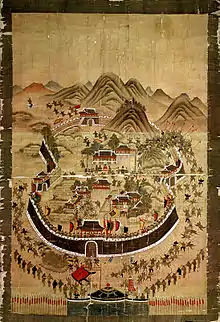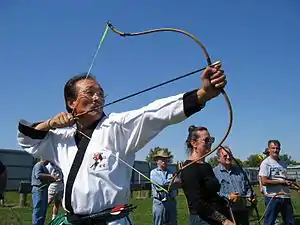Korean martial arts
Korean martial arts (Korean: 무술 or 무예) are fighting practices and methods which have their place in the history of Korea but have been adapted for use by both military and non-military personnel as a method of personal growth or recreation. The history of Korean martial arts can be traced as far back as the prehistoric era.
| Korean martial arts | |
.jpg.webp) Taekwondo at the 2014 Asian Games | |
| Korean name | |
|---|---|
| Hangul | 무술 |
| Hanja | 武術 |
| Revised Romanization | Musul |
| McCune–Reischauer | Musul |
| Alternate term | |
| Hangul | 무예 |
| Hanja | 武藝 |
| Revised Romanization | muye |
| McCune–Reischauer | muye |
 |
| Part of a series on the |
| Culture of Korea |
|---|
| Society |
| Arts and literature |
| Other |
| Symbols |
|
Notable examples of unarmed martial arts include taekwondo, hapkido, ssireum, and taekkyon. For armed martial arts, Korean archery, Kumdo, Korean swordsmanship, and knife fighting exist. In November 2011, taekkyon was placed on the UNESCO Intangible Cultural Heritage of Humanity List.[1]
History
Early history
Wrestling, called ssireum, is the oldest form of ground fighting in Korea, while Subak was the upright martial art of foot soldiers. Weapons were an extension of those unarmed skills. Besides being used to train soldiers, both of these traditional martial arts were also popular among villagers during festivals for dance, mask, acrobatic, and sport fighting. These martial arts were also considered basic physical education. However, Koreans relied more heavily on bows and arrows in warfare than they did on close-range weapons.[2]
It appears that during the Goguryeo dynasty, (37 BC – 668) subak/taekkeyon or ssireum (empty-handed fighting), swordsmanship, spear-fighting and horse riding were practiced. In 1935, paintings that showed martial arts were found on the walls of royal tombs believed to have been built for Goguryeo kings sometime between the years 3 and 427 AD.[3] Which techniques were practiced during that period is, however, something that cannot be determined from these paintings. References to Subak can be found in government records from the Goguryeo dynasty through the Joseon dynasty, until the 15th century, after which its popularity declined It reappears only in 1790 book about martial arts titled Muyedobotongji (무예도보통지).[4]
Joseon

In 1593, during the 1592–1598 Japanese invasions of Korea, Korea received help from China to win back Pyongyang. During one of the battles, the Koreans learned about a martial art manual titled Ji Xiao Xin Shu (紀效新書), written by the Chinese military strategist Qi Jiguang. King Seonjo (1567–1608) took a personal interest in the book, and ordered his court to study the book. This led to the creation of the Muyejebo (무예제보; 武藝諸譜) in 1599 by Han Gyo, who had studied the use of several weapons with the Chinese army. Soon this book was revised in the Muyejebo Seokjib and in 1759, the book was revised and published at the Muyesinbo (무예신보; 武藝新譜).[5]

In 1895, Emperor Gojong invited 40 sword masters from Japan to begin teaching the art of the sword to his Korean Army cadets and police officers. This was decided upon due to the lack of native sword masters in Korea at the time. Teachings continued well after the 1910 Annexation, until the art was formally named Kendo in Japan, and Kumdo in Korean.
In 1899, Emperor Gojong, with the encouragement of the visiting Prince Heinrich of Prussia, established gungdo as an official sport.[6]
During the Donghak Rebellion, much of the rebels used old matchlock arquebuses against the modern rifles of the Korean and Japanese Army. Although the rebels initially fought against the Korean government, following the fall of Jeonju, the Korean government had invited in the Japanese Army to help suppress the peasant rebels. With the annexation of Korea in 1910, all matchlocks were confiscated and destroyed by the Japanese. However, the Japanese did not stop the production and keeping of bows, which they did not consider as a threat to internal security.
Modern Korean martial arts
The two extant martial arts at the time of Japanese take over in 1910, ssireum and gungdo grew in popularity during the Japanese occupation period, both of them founding their current federations in 1920. Taekkyon did not enjoy much popularity during the occupation era.[7]
Currently these new arts such as taekwondo and hapkido created since 1945 remain the most popular in Korea. Other modern styles such as Tae Soo Do and Hwa Rang Do, which have a sizeable presence in the US and Europe, are almost unknown in Korea, as the founders relocated to the US and focused on operations in the US. Gungdo participation is limited by the high cost of the equipment, with a traditional horn made reflex bow costing upwards of $1000, and most gungdo clubs in Seoul charging over $1000 application fee for membership, similar to golf clubs. This limits participation to the upper and upper middle class. Many Korean junior high schools, high schools, and colleges maintain martial arts teams to include ssireum, kumdo (kendo), judo and taekwondo. Yong In University for instance, focuses on martial arts training for international competitions.[8]
Types of Korean martial arts
Taekwondo
Taekwondo is the national sport of both Koreas and the most recognized of the Korean martial arts. It is practiced by millions of people around the world.[9]
Taekkyon/Taekkyeon
Taekkyon is acknowledged as one of the oldest martial arts of Korea.[10] Song Deok-gi was the last Taekkyon Master of the Joseon dynasty.[11]
On June 1, 1983, Taekkyon was made the Important Intangible Cultural Properties of Korea No. 76 by the South Korean government.[12][13] It is one of two Korean martial arts which possesses such a classification. In November 2011, Taekkyon was recognized on the UNESCO's Intangible World Heritage Art list.[14]
Subak
Subak[15] is an ancient Korean martial art.
Tang Soo Do/Soo Bahk Do
Tang Soo Do is a striking martial art, which was developed during the 20th century, yet it has its roots in ancient Korean martial arts, as well as martial arts from other nations.
Hapkido
Hapkido is partly based on Japanese Daitō-ryū Aiki-jūjutsu with Korean striking techniques.
Hanmudo
Hanmudo (한무도) is a hybrid Korean martial art developed by Dr He-Young Kimm. He founded the World Hanmudo Association in 1989.[16]
Gungdo

The reflex bow had been the most important weapon in Korean wars with Chinese dynasties and nomadic peoples, recorded from the 1st century BCE.[17] Legend says the first king and founder of the Goguryeo, Go Jumong, was a master of archery, able to catch 5 flies with one arrow. Park Hyeokgeose, the first king of the Silla, was also said to be a skilled archer.
Until the Imjin wars, the tactical superiority of the matchlock arquebus became apparent, despite its slow rate of fire and susceptibility to wet weather.[18] However, it was the Korean composite bow, referred to as the "half bow" by the Japanese, that halted the Japanese at the Battle of Haengju as well as at the Battle of Ulsan.
References
- "UNESCO Culture Sector - Intangible Heritage - 2003 Convention". Unesco.org. Retrieved 2014-02-19.
- Draeger, Donn F. (1981). Comprehensive Asian Fighting Arts, pg 155. Kodansha International.
- 亞洲文化. Vol. 3. Asian Cultural Center. 1975. p. 30.
- "수박" (in Korean). Doopedia. Retrieved 2020-11-17.
- Kim, Wee-hyun. "Muyedobo T'ongji: Illustrated Survey of the Martial arts." Korea Journal 26:8 (August 1986): 42-54
- "Gungdo 국궁 | Taekwondo Preschool". www.taekwondopreschool.com. Retrieved 2023-10-16.
- "Korean Martial Arts". MARTIAL ARTS INTERNATIONAL FEDERATION (MAIF). Retrieved 2023-10-16.
- "Department of taekwondo". Archived from the original on 2014-03-30. Retrieved 2012-02-20.
- Kim, Yu-jin (2021-10-30). "The Psychosocial Effects of Taekwondo Training: A Meta-Analysis". Int J Environ Res Public Health. 18 (21): 11427. doi:10.3390/ijerph182111427. PMC 8583609. PMID 34769961.
- "Taekkyon is believed to be one of the earliest forms of Korean martial arts". 13 November 2017.
- "Fortunately Song Deok-ki (1893-1987) preserved the art and handed it down to modern day Koreans".
- Jin, Su-geon; So, Wi-Young; Seo, Dong-il (2022-10-26). "Comparative Analysis of Exercise Intensity in Taekkyeon Training Movements". Journal of Men's Health. 18 (10): 209. doi:10.31083/j.jomh1810209. ISSN 1875-6867.
- "Taekkyeon (Traditional Korean Martial Art)". Cultural Heritage Administration - English Site. Cultural Heritage Administration. Retrieved 2023-08-17.
- "Inscribed in 2011 (6.COM) on the Representative List of the Intangible Cultural Heritage of Humanity".
- "World Martial Arts Styles".
- "About Hanmudo". hanmudo.com. Retrieved 2022-11-21.
- Duvernay, Thomas. "Korean Traditional Archery". www.atarn.org.
- Korean Traditional Archery. Duvernay TA, Duvernay NY. Handong Global University, 2007
Further reading
- Adrogué, M. (2003). "Ancient military manuals and their relation to modern Korean martial arts". Journal of Asian Martial Arts. 12: 4.
- Della Pia, J. (1994). "Korea's Mu Yei Do Bo Tong Ji". Journal of Asian Martial Arts. 3: 2.
- Henning, S. (2000). "Traditional Korean martial arts". Journal of Asian Martial Arts. 9: 1.
- Kim, S. H. (2001): Muye Dobo Tongji. Turtle Press.